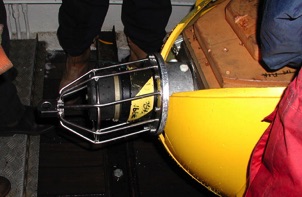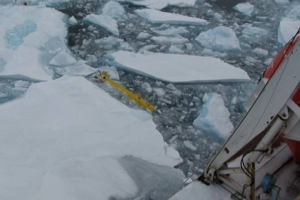Managing risk is essential to the effective use of autonomous underwater vehicles (AUVs) in marine science, industry and defence applications. One option for managing risk is to transfer it to, or to share it with, others. Over the last two decades, increasing use has been made of commercial insurance by marine science and commercial operators of AUVs. In the recent past, as more vehicles are sold to operators, the risks have changed; and as insured vehicles have been lost, severely damaged, or required expensive retrieval, the cost of AUV insurance has increased - underwriters are in business to make profit.
This page explores the relationships between the client seeking insurance for an AUV, the insurance broker, and the underwriter of the risk. We also outline what might happen following a claim and discuss a number of factors that might affect the cost of insurance for an AUV. To illustrate these points we present two case studies from experienced developers and users.
The role of an Insurance Broker
The client will first need to contact an insurance broker. The broker is the agent of the client and will need to develop an understanding of the client's AUV operations in order to best represent their interests and ensure that the cover bought is the best value and appropriate for the intended missions. In theory, it is also possible for the client to go directly to the underwriting markets to obtain insurance. However, via this route the client has no guarantee that they will find the best value. The issues are complex and it is important to have an insurance professional to advise on the types of cover, what they actually provide, and, in the event of a claim, to represent the client's interests.
Insurance Markets, Underwriters and Binding Authorities
One insurance market is Lloyd's of London. Lloyd's is a specialist insurer that is capitalised by some of the largest financial companies. While the spirit of risk taking and innovation is still foremost, Lloyd's is now regulated by the UK Financial Services Authority, and the Corporation of Lloyd's provides guarantees of security through the quality of its investors and rigorous internal checks.
Into this world came the first subsea risks. Unlike the maritime industry, in which the early underwriters had themselves been seafarers, Lloyd's underwriters in the 1970s were unfamiliar with subsea robotics. Risks at Lloyd's were at that time normally spread over a number of different syndicates, which meant that a number of underwriters had to feel the risk was worth assuming. Underwriters must of necessity turn a profit and so into this specialised arena came specialist companies. One such example was Leviathan, a binding authority that was supported by seven Marine and Energy Syndicates at Lloyd's and was specifically set up to underwrite specialist subsea risk on behalf of Lloyd's Underwriters. Since 2016 Leviathan has been a part of the Beazley Group. Other specialist companies include NMU, and in the USA, AMI.
(Mention of specific companies on this site does not imply the SUT endorses them or their products).
Scope of an Insurance Policy
AUVs are complex. They are also intended for use in unusual or hazardous conditions. It is therefore most important that the wording of the insurance contract for an AUV provides the coverage that the client requires:
• On land - in storage, and if the vehicle is being launched and recovered from shore.
• In Transit - while being transported, by land, sea or air.
• During upkeep - while being maintained, modified or upgraded.
• At Sea - while in operation, including launch and recovery, monitored transit and unattended operations.
To ensure that the wording meets the client's requirements, the underwriter is likely to meet with the client to understand first-hand their business, their operation and the likely risks.
Other options include:
• Third party liability - likely to be taken on a case by case basis.
• Consequential damages - likely to be hard to find if the AUV is a prototype or self-build.
Response to an Incident
The first response to an incident that may result in a claim is for the client to 'act as a prudent uninsured' in the steps that are taken. There has to be a cut-off point, for example, on the time (and hence money) spent on searching. It may be that when a vehicle is lost, the client may have suitable equipment to effect a recovery, for example an ROV with an experienced support team. Under a 'sue and labour clause', the client will be able to claim for the additional costs incurred in locating and retrieving the AUV.
Underwriters outsource claims to an adjuster to avoid conflict of interest. In the case of damage, the adjuster may survey the vehicle, check that the claim falls within the scope of the insurance, and examine the options with the client to put the vehicle back into the condition it was in before the incident.
Soon after a claim has been lodged, the underwriter will table the total costs of the claim, including all fees. The record of the client will show the loss against premiums paid. If an incident occurs that is within the deductible on the policy, especially for a newly insured AUV, the underwriter may suggest that a loss adjustor look at the case to exercise the process and possibly identify any improvements that may be necessary.
Factors Affecting the Cost of Insurance
Among the factors that are likely to affect the cost of insurance for an AUV are:
• Experience, track record, qualifications and training of the staff involved with the AUV;
• Vessel operators involved in launch and recovery;
• Evidence of clear risk assessments, checks and controls in operating procedures;
• Evidence of risk mitigation measures. These might include technical measures, such as homing and emergency beacons, and procedural measures, such as maximum allowed sea states for recovery;
• Details of the operating environment and its specific risks;
• The extent of co-insurance between the underwriter and the client.
Insurance is one important element in the risk management strategy for the owners and operators of AUVs. The two case studies point to the need for open and constructive dialogue between users/manufacturers and insurance professionals - especially with underwriters. Where there has been effective communication, the case studies show that helpful risk management solutions, including insurance, can be reached.
Insurance - One method of Managing Risk
References
Griffiths G., Millard NW., McPhail SD., Stevenson P. and Challenor PG. (2003). On the Reliability of the Autosub Autonomous Underwater Vehicle. Underwater Technology, 25(4): 175-184.
Griffiths, G., Bose, N., Ferguson, J. and Blidberg, D.R., 2007. Insurance for autonomous underwater vehicles. Underwater Technology, 27(2), pp.43-48. Available here.
Griffiths, G. and Trembanis, A., 2007. Towards a risk management process for autonomous underwater vehicles. Masterclass in AUV Technology for Polar Science, pp.103-118. SUT, London. Chapter pre-print available here.
Strutt J. (2006). Report of the inquiry into the loss of Autosub2 under the Fimbulisen. National Oceanography Centre, Southampton, UK. 39pp. Available as a pdf via http://eprints.soton.ac.uk/41098/
Ferguson J. (2003). Cargo carrying AUVs. In Griffiths G. (editor) Technology and applications of autonomous underwater vehicles, 217-226. Taylor and Francis, London, UK.


